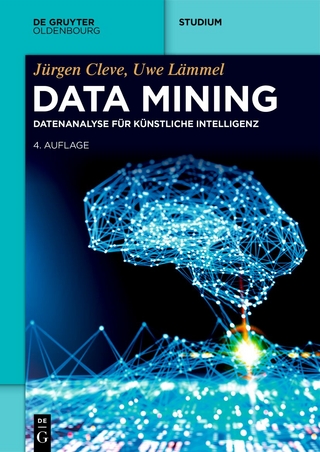
Introduction to Deep Learning Using R
Apress (Verlag)
978-1-4842-2733-6 (ISBN)
- The code in this book utilizes R studio and its packages, all of which are open source, to make the learning process as simple as possible
- Each chapter builds upon the knowledge of the preceding chapter
- The book has two main sections: Theory and Applications. Although theory will be covered in depth, the purpose of this book is to give readers the necessary knowledge to apply these models.
Understand deep learning, the nuances of its different models, and where these models can be applied.
The abundance of data and demand for superior products/services have driven the development of advanced computer science techniques, among them image and speech recognition. Introduction to Deep Learning Using R provides a theoretical and practical understanding of the models that perform these tasks by building upon the fundamentals of data science through machine learning and deep learning. This step-by-step guide will help you understand the disciplines so that you can apply the methodology in a variety of contexts. All examples are taught in the R statistical language, allowing students and professionals to implement these techniques using open source tools.
You'll Learn
- Understand the intuition and mathematics that power deep learning models
- Utilize various algorithms using the R programming language and its packages
- Use best practices for experimental design and variable selection
- Practice the methodology to approach and effectively solve problems as a data scientist
- Evaluate the effectiveness of algorithmic solutions and enhance their predictive power
This book is for students, researchers, and data scientists who are familiar with programming using R. This book also is also of use for those who wish to learn how to appropriately deploy these algorithms in applications where they would be most useful.
Taweh Beysolow II is a Machine Learning Scientist currently based in the United States with a passion for research and applying machine learning methods to solve problems. He has a Bachelor of Science degree in Economics from St. Johns University and a Master of Science in Applied Statistics from Fordham University. Currently, he is extremely passionate about all matters related to machine learning, data science, quantitative finance, and economics.
Chapter 1: What is Deep Learning?Chapter Goal: Review the history of Deep Learning, how where the field is today, and discuss the general goals that the book has for the reader in their progression.No of pages 10Chapter 2: A Review of Notation, Vectors and MatricesChapter Goal: Establish a sense of understanding in the aforementioned topics within the reader to allow them to understand the models described later. Topics discussed includes the following: Notation, vectors, matrices, inner products, norms, and linear equations.No of Pages: 50 Apress Proposal Submission Form for Prospective AuthorsChapter 3: A Review of OptimizationChapter Goal: Discuss/Review Optimization concepts and how it is used in Deep Learning models. Topics discussed include the following: constrained and unconstrained optimization, gradient descent, and newton's method.No of pages : 60Chapter 4: Single Layer Artificial Neural Network (ANNs)Chapter Goal: Introduce readers to ANNs, it's uses, the math that powers the model, as well as discussing its limitationsNo of pages: 10Chapter 5: Deep Neural Networks (Multi-layer ANNs)Chapter Goal: Establish the difference between single and multilayer ANNs as well as discuss the nuances that are created as a product of having multiple hidden layersNo of pages: 10Chapter 6: Convolutional Neural Networks (CNNs)Chapter Goal: Build upon the knowledge of neural networks described earlier and begin to branch in the other models, such as CNNs. Here, we will establish what a convolutional layer is, in addition to what the uses of this model are, such as computer vision and processing visual data.No of pages: 10 Apress Proposal Submission Form for Prospective AuthorsChapter 7: Recurrent Neural Networks (RNNs)Chapter Goal: Describe the mathematics and intuition behind RNNs and their use cases, such as handwriting recognition and speech recognition. Also describe how the unique structure behind them differentiates themselves from feed forward networks.No of pages: 10Chapter 8: Deep Belief Networks and Deep Boltzman MachinesChapter Goal: Discuss the similarities between these two models and how their disadvantages and advantages in contrast to the prior Deep Learning Models describedNo. of pages: 20Chapter 9: Tuning and Training Deep Network ArchitecturesChapter Goal: Establish an understanding of how to properly train Deep Network models and tune their parameters as to avoid common pitfalls such as overfitting.No. of Pages: 20Chapter 10: Experimental Design and Variable SelectionChapter Goal: Now that the reader has an understanding of various Deep Learning Models, and the concepts that power them, it is time to establish an understanding of how to properly perform experiments, including the examples given in the later part of the text. Topics discussed include the following: Fisher's priciples, Plackett-Burman designs, statistical control, and variable selection techniques.No. of Pages: 60 Chapter 11: Example ProblemsChapter Goal: In this Chapter, the user will be given questions and detailed answer guides in solving the supervised and unsupervised learning example problems. Problems covered are the following: Regression, Classification, and Image Recognition.No of Pages: 60Chapter 12: Conclusion and Closing CommentaryChapter Goal: Give readers recommendations on what resources they should seek moving forward given specific interests, as well as recommendations for what tools they should use related to R.No. of Pages: 5
| Erscheinungsdatum | 06.08.2017 |
|---|---|
| Zusatzinfo | 53 b/w illustrations, 53 illustrations in colour |
| Verlagsort | Berkley |
| Sprache | englisch |
| Maße | 155 x 235 mm |
| Gewicht | 391 g |
| Einbandart | kartoniert |
| Themenwelt | Informatik ► Datenbanken ► Data Warehouse / Data Mining |
| Mathematik / Informatik ► Informatik ► Programmiersprachen / -werkzeuge | |
| Mathematik / Informatik ► Informatik ► Software Entwicklung | |
| Informatik ► Theorie / Studium ► Compilerbau | |
| Informatik ► Theorie / Studium ► Künstliche Intelligenz / Robotik | |
| Mathematik / Informatik ► Mathematik ► Finanz- / Wirtschaftsmathematik | |
| Wirtschaft ► Betriebswirtschaft / Management | |
| Schlagworte | Anwendungen • Deep learning • Programmiersprache R |
| ISBN-10 | 1-4842-2733-6 / 1484227336 |
| ISBN-13 | 978-1-4842-2733-6 / 9781484227336 |
| Zustand | Neuware |
| Informationen gemäß Produktsicherheitsverordnung (GPSR) | |
| Haben Sie eine Frage zum Produkt? |
aus dem Bereich


